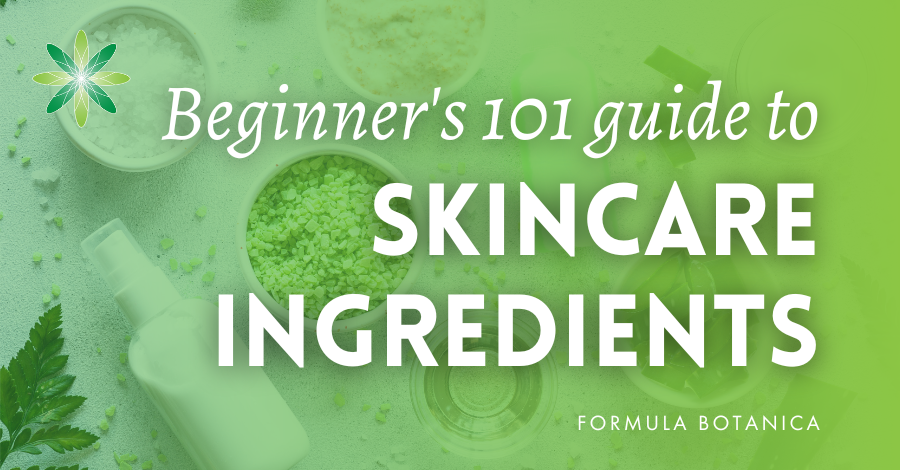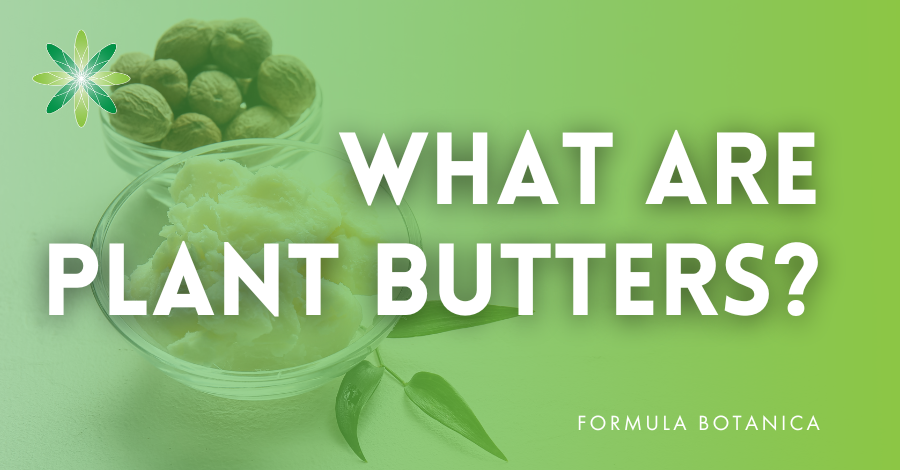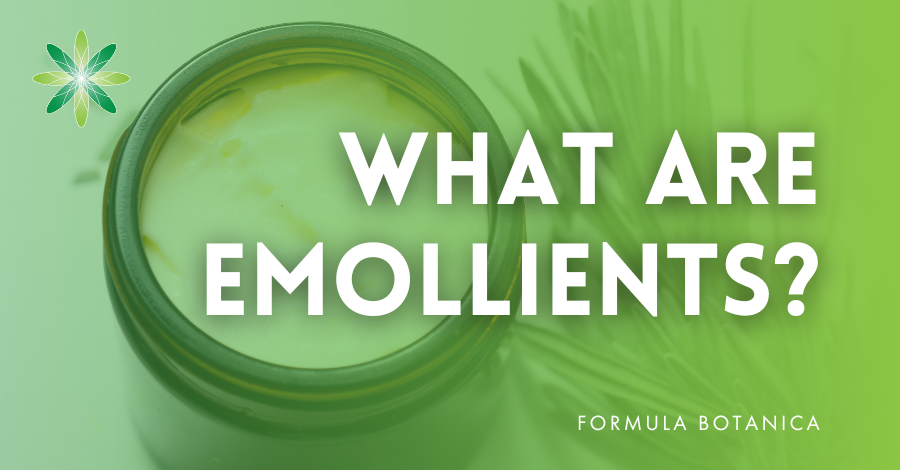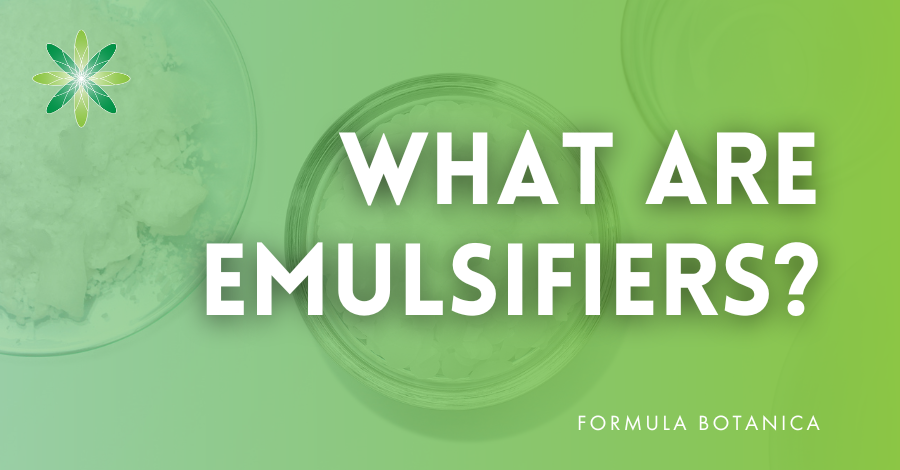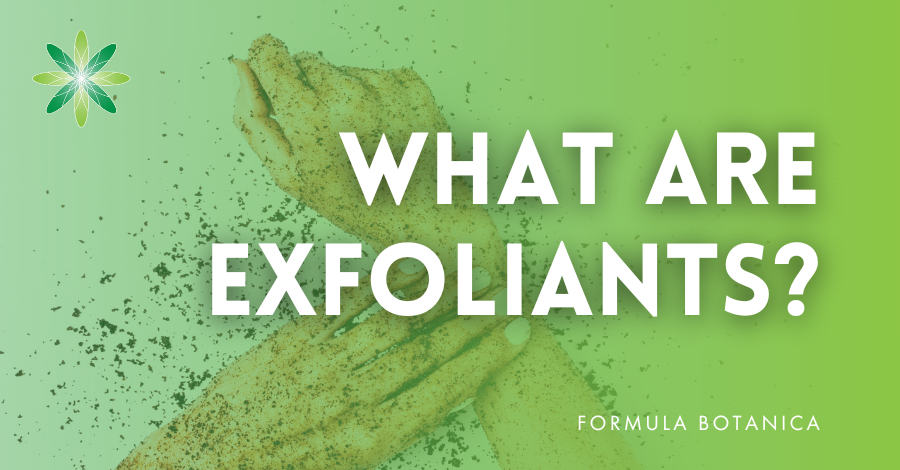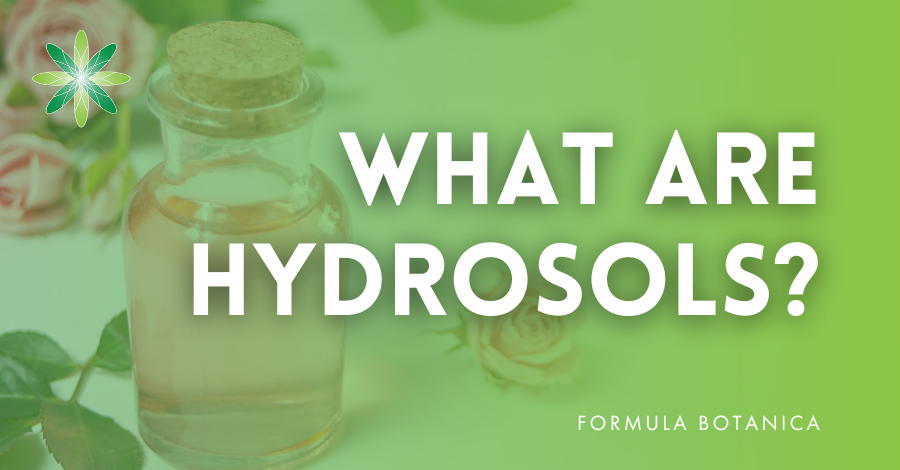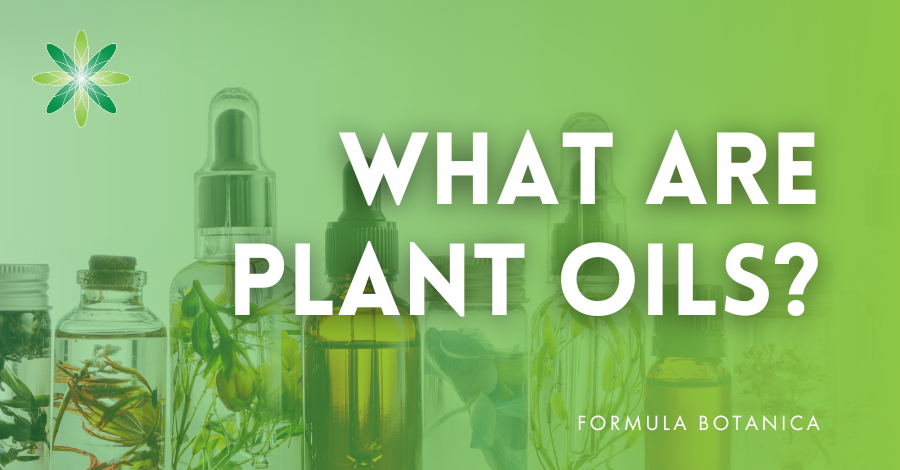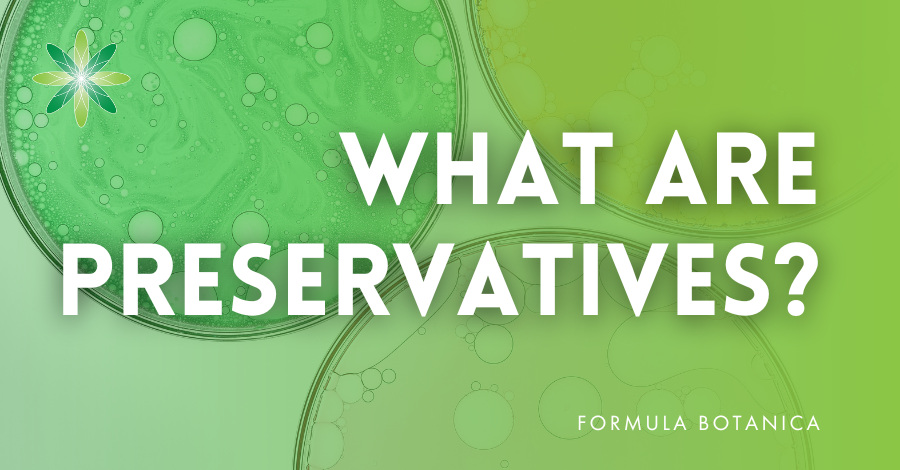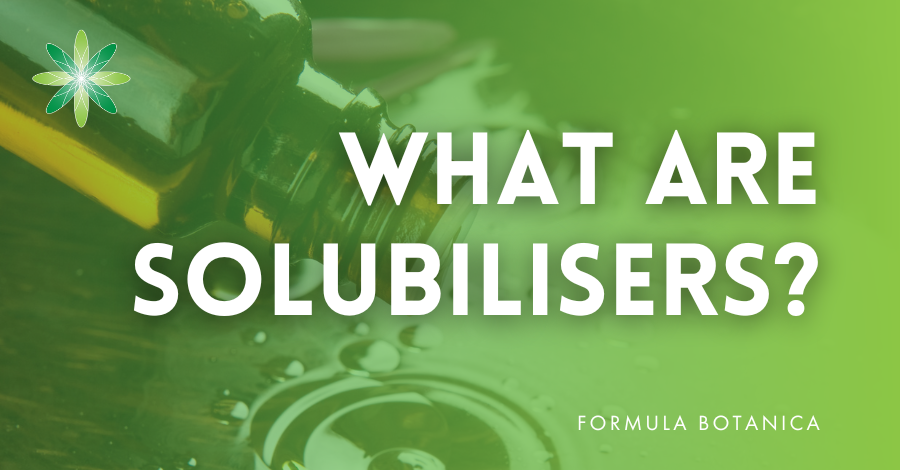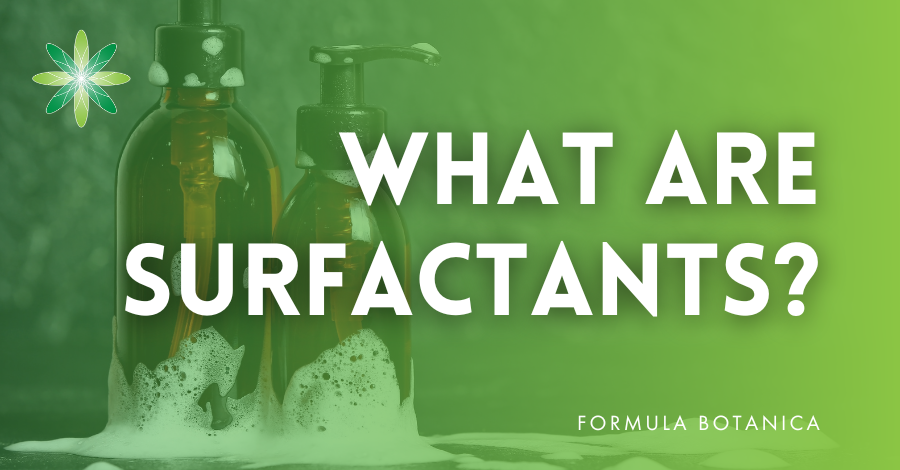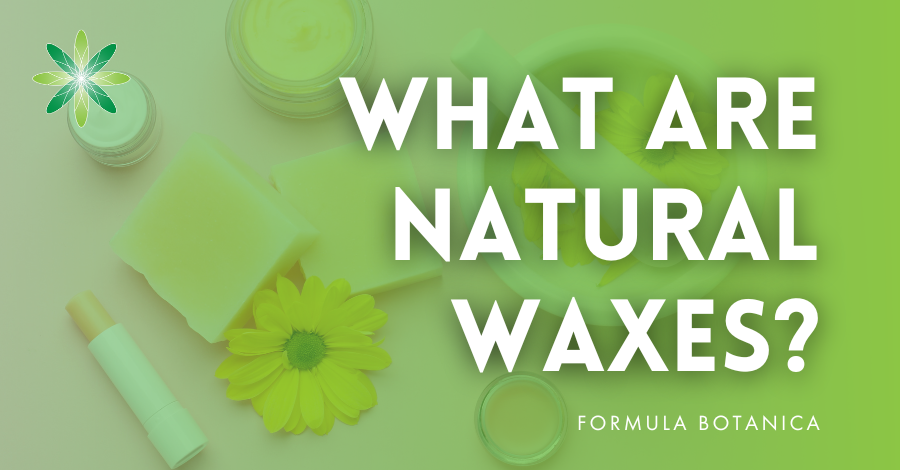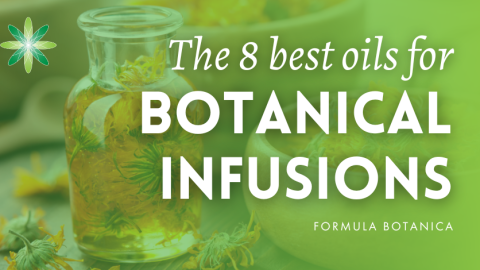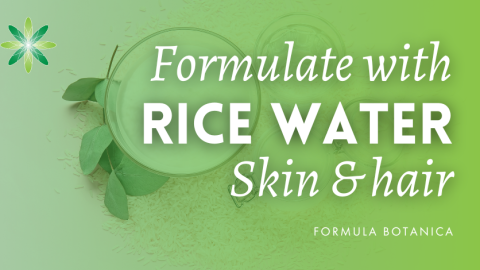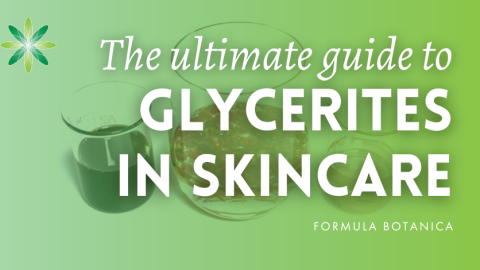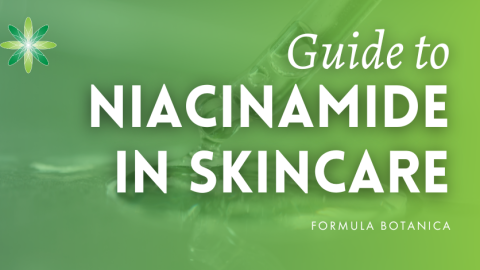As a beginner to natural formulation, you enter a whole new world of botanical skincare ingredients, which is exciting but can be overwhelming to explore. Where do you begin to choose from the hundreds of plant-derived ingredients, and what are those categories that formulas mention, such as humectants and solubilisers?
You may be familiar with some terms from cooking. Food recipes talk about emulsifying and stirring to a trace when we make things like mayonnaise and sauces. This analogy is a good one, as at Formula Botanica, we believe that everyone can formulate, just as everyone can cook, and our aim is to demystify the cloak of complexity that the mainstream beauty industry evokes. For instance, there is no need to be a chemist or have a science background to be a competent cosmetic formulator.
However, there are some basics to learn to get you started, and familiarity with core terms and categories of ingredients is a must. You need to know what they are even when searching suppliers’ sites to buy your first set of ingredients.
In this guide, we cover the key ingredient categories and explain what they are used for in formulation to get you started with less confusion. We point to more in-depth articles to explore. For now, let’s explain, in simple terms, the top 10 common categories of cosmetic ingredients. You can go to the skincare ingredient you are interested in by using these links:
Butters
Emollients
Emulsifiers
Exfoliants
Hydrosols
Botanical oils
Preservatives
Solubilisers
Surfactants
Natural waxes
Butters
Botanical butters are usually derived from the seeds, pips or nuts of plants. Most butters are solid at room temperature and melt when in contact with the skin. They are solid because of their fatty acid composition, which comes directly from the plant, and can be rich in antioxidants and other beneficial compounds like vitamins and phytosterols.
There are also hydrogenated plant oils that look like butters and are sometimes called “butters”. These are accepted by natural certification standards, but they are not true butters. They are made by extracting the oil from the plant material and then solidifying it, which may include a process of hydrogenation or blending with other solid fats.
Butters can undergo refining, bleaching, and deodorising to remove impurities, strong colours, or scents. In general, the more processed the butter is, the less likely it is to include the properties we desire in natural formulations.
Butters are excellent at protecting the skin barrier. As highly versatile ingredients, they can be used in a wide range of formulations, including body butters, balms, and facial creams. They can help to nourish and moisturise the skin (by reducing transepidermal water loss – TEWL), improve skin elasticity, and protect against environmental stressors. Additionally, they can be used as thickeners, and stabilisers in formulations.
Some of the most popular botanical butters used in natural skincare products include shea butter, cocoa butter, and mango butter. You can explore shea and other gorgeous butters in these articles:
15 tips on formulating with shea butter
5 Amazonian butters for organic skincare formulations
10 natural African skincare ingredients
Emollients
Emollients are a category of cosmetic ingredients that play a crucial role in skincare formulations as they help to soften, smooth, and moisturise the skin by forming a protective barrier on its surface. Emollients are especially beneficial for dry, rough, or irritated skin, as they help to maintain the skin’s moisture, promoting a supple complexion.
Natural emollients are derived from various botanical sources, including plant oils, butters, and waxes. Examples of natural emollients commonly used in botanical skincare and ideal for the beginner formulator to work with include:
Jojoba oil: This is an excellent emollient derived from the seeds of the jojoba plant. Its composition is biomimetic in that it closely resembles skin sebum, making it easily absorbed and well-tolerated by most skin types. Jojoba oil (it’s a liquid wax, but commonly called an oil) helps to balance the skin’s sebum production, moisturise the skin, and improve its elasticity. It also has soothing and anti-inflammatory properties, making it especially suitable for sensitive or acne-prone skin.
Shea butter: Derived from the nuts of the shea tree, shea butter is a rich emollient known for its exceptional moisturising properties. It is packed with fatty acids, vitamins, and antioxidants that nourish the skin. Shea butter forms a protective barrier on the skin’s surface, sealing in moisture and preventing moisture loss. It helps to soften dry patches, soothe irritation, and promote a smooth and supple complexion. See our complete guide to shea butter.
Coconut oil: Coconut oil, obtained from the flesh of mature coconuts, is a versatile emollient used in many natural skincare products. It contains medium-chain fatty acids that have excellent emollient properties. Coconut oil helps to moisturise and soften the skin, leaving it feeling smooth and refreshed. It also has antimicrobial properties, making it beneficial for certain skin conditions.
These natural botanical emollients provide a range of benefits for the skin, including nourishment and protection. They are widely used in natural skincare formulations on account of their compatibility with the skin, effectiveness in moisturising, and their ability to provide a luxurious feel to products. Incorporating these emollients into botanical skincare routines can help maintain skin health and improve its overall appearance.
Emulsifiers
Cosmetic emulsifiers are ingredients that help to combine two or more immiscible substances, such as oil and water, into a stable mixture called an emulsion. Without an emulsifier, the oil and water components of a product would separate, making it unusable. Emulsifiers can be natural or synthetic and are an essential ingredient in many natural skincare formulations as they allow for the creation of creams, lotions, and other emulsion-based products.
Emulsifiers work by having one end of their molecule attracted to water (hydrophilic) and the other end attracted to oil (lipophilic). This allows the emulsifier to act as a bridge between the two substances, creating a stable mixture. The amount and type of emulsifier used will depend on the specific formulation and the desired texture and stability of the product.
Each emulsifier has slightly different properties, not only in terms of its skin feel in the final product but also in terms of its use. There are emulsifiers for oil-in-water emulsions (O/W) and water-in-oil (W/O) emulsions, and some that can be used in hot- or cold-blended formulations.
Choosing the right emulsifier is important for creating stable and effective natural skincare products like lotions and moisturisers. It is also important to note that the amount of emulsifier used can affect the texture and feel of the final product. You will become more familiar with all these options as you progress in natural formulation.
See our post:
Everything you ever wanted to know about natural emulsifiers
In fact, emulsifiers are fascinating ingredients, and our tutors love exploring new ones that come onto the market. While making an emulsion may seem complex, it is well within the scope of the beginner formulator and extremely satisfying to achieve. The first emulsifier on the list below is very versatile, and you will find it used in many beginner-level formulations.
Some common emulsifiers used in natural cosmetic formulations include:
Olivem 1000 – this is a natural emulsifier derived from olive oil that is often used in facial creams and serums.
Lecithin – this is a versatile ingredient that can also be used as a natural emulsifier. It is derived from soybeans or sunflowers and can be used in a variety of formulations.
Cetearyl olivate/sorbitan olivate – this is a natural emulsifying wax derived from olive oil that is often used in moisturisers and facial creams.
You might like to try making this simple oil-in-water emulsion using Olivem 1000.
Exfoliants
Exfoliants are ingredients that help remove dead skin cells from the surface of the skin. They can be physical exfoliants such as sugar or salt scrubs, or chemical exfoliants such as alpha-hydroxy acids (AHAs) and beta-hydroxy acids (BHAs). Exfoliants can help improve skin texture, unclog pores, and brighten the complexion.
Physical exfoliants work by manually removing dead skin cells from the surface of the skin. They are typically made of granular materials such as sugar, salt, or ground nuts and seeds. Some of these exfoliants can be too abrasive for some skin types and are suited either for face or body formulations according to the size of the particles. It is therefore important to choose one that is appropriate for your skin and the area of the body on which it will be used so as to not cause irritation. We have a simple body exfoliator formulation you can try:
Chemical exfoliants, on the other hand, work by breaking down the bonds between dead skin cells, allowing them to be easily removed. AHAs such as glycolic acid and lactic acid are water-soluble and can help brighten the skin and reduce the appearance of fine lines and wrinkles. BHAs such as salicylic acid are oil-soluble and can penetrate deep into the pores to help unclog them. Chemical exfoliants are typically used within very specific percentage ranges in cosmetic formulations to ensure their safe use.
This article does an excellent job of explaining the different chemical exfoliants in more detail:
Hydrosols
Pure hydrosols are produced mainly as a by-product of steam-distilling plant material for the production of essential oils. They are made up of water-soluble components of the plant along with minute amounts of extracts found in the essential oil. Hydrosols are typically used in facial toners, body sprays, and micellar waters, to form part of the water component in emulsions, or as a base for other skincare products.
Hydrosols are gentle and have a subtle fragrance, though not always a scent you may associate with the original plant or flower. They make an excellent choice for sensitive skin types. Rose water is one of the most popular hydrosols used in skincare formulations. It can help soothe and calm the skin. Lavender hydrosol is another popular choice that can help cleanse, balance, and tone the skin. Hydrosols can also be used as a base for natural perfumes or added to bathwater for a relaxing aromatherapy experience.
While hydrosols seem easy to understand, it is worth reading up on their differences, as not all hydrosols are genuine plant distillates. Some may be marketed as hydrosols but are in fact created by solubilising (see the definition below) small amounts of essential oil in water. Our guide explains this and more in full:
Botanical oils
Oils are a much-loved and common category of cosmetic ingredients derived from plants, nuts, and seeds. We compiled a top-ten list of Formula Botanica tutors’ favourite botanical oils, ones they recommend every beginner formulator should have in their store cupboards.
Botanical oils can be used in various formulations, such as facial oils, body oils, and serums, and are included in emulsion formulations in the oil phase along with butters and waxes. In general, botanical oils are rich in fatty acids, antioxidants, and vitamins, making them excellent for nourishing and protecting the skin.
Some popular botanical oils include jojoba, which we mentioned above, and rosehip oil, which is high in essential fatty acids and is common in formulations aimed at mature skin and at alleviating the appearance of scars and stretch marks. Other popular oils used in natural skincare include argan oil, coconut oil, and sweet almond oil.
Dive into the wonderful world of botanical oils in these two guides:
Why you need seed oils in your skincare and haircare
Top 10 botanical oils every formulator needs
Preservatives
Preservatives are ingredients used to prevent microbial growth in a water- or water-based formulation. That said, even some anhydrous (waterless) formulations may require a preservative if they are used in a damp, humid environment such as bathrooms or come into contact with wet hands when being dispensed. Without a preservative, a product would have a short shelf life and could potentially become contaminated with harmful microorganisms (bacteria, moulds, and yeasts).
Common natural preservatives include potassium sorbate and benzyl alcohol. Preservatives in cosmetics have come under scrutiny in recent years, partly on account of the media focusing in particular on parabens and their alleged role in health concerns including hormone disruption and skin irritation. We cover this in our Green Beauty Conversations episode:
Parabenoia – how parabens kickstarted the indie beauty movement
As a beginner formulator, it is important to know that you need your cosmetics to be adequately preserved, as the safety of yourself and that of your customers if you sell your formulation later on is paramount. You may wish to read more on natural preservatives in these articles:
Everything you wanted to know about natural preservatives
Can your cosmetics kill you?
When even phenoxyethanol fails – the Liz Earle recall
Solubilisers
Solubilisers are skincare ingredients that help dissolve oil-based ingredients in water-based products; mostly, we are talking about small amounts of essential oils rather than fixed carrier oils. They are common in products such as facial cleansers and micellar waters, where oil and water-based ingredients need to be combined.
Solubilisers ensure that the essential oils are evenly distributed, and they help create clear and stable formulations. This is important for cosmetic safety reasons, as essential oils added to water-based products without being properly solubilised would pool or float on the surface and therefore be highly concentrated when in contact with the skin. You can read up on the role and function of solubilisers in these posts:
Guide to four natural solubilisers for cosmetic formulation
How to formulate a micellar water with vitamin B
Surfactants
Surfactants (short for surface-active agents) are ingredients that can help cleanse the skin by reducing the surface tension between water and the sebum or dirt on our skin. They can be natural or synthetic, have different levels of cleansing power, and are also used to create foam (although foaming is not necessary in order to cleanse). They are often used in facial cleansers, shampoos, and body washes and help remove dirt, oil, and makeup from the skin. Surfactants comprise a large group of cosmetic ingredients that also includes some emulsifiers and solubilisers.
Natural surfactants include decyl glucoside, sucrose cocoate, and cocamidopropyl betaine (the latter is semi-synethetic, but accepted by natural certification standards because there are no totally natural options for amphoteric surfactants). Surfactants also come in solid forms (such as sodium cocoyl isethionate or SCI) for use in waterless, solid formulations like shampoo and cleansing bars. As there is more to know about just how they function (as a result of their differing electrical charges), we suggest reading our guide and the introductions to these formulations:
5 natural solubilisers for use in organic cosmetics
How to make a natural shower gel with surfactants
How to make a jasmine and mandarin clarifying shampoo
Make a natural shampoo with mint and rosemary
How to make a solid cleansing bar
Waxes
Waxes are a category of cosmetic ingredients derived from plants or other sources like beeswax. They can be used in various formulations, such as lip balms, body butters, and creams. Waxes provide a protective or occlusive barrier on the skin. They are used to perform a variety of roles in cosmetics, from hardening and stabilising formulations and acting as a protective barrier on the skin (locking in moisture and preventing dehydration) to adding shine, which is useful for lip preparations, to adjusting the melting point of cosmetics.
Natural waxes are typically gentle on the skin and have a low risk of causing irritation or allergic reactions. Beeswax is a popular natural wax that is commonly used in lip balms, body butters, and other skincare products. Candelilla wax is a botanical wax that is commonly used as a vegan alternative to beeswax.
Waxes may seem rather uninteresting functional skincare ingredients, but they play important roles in your cosmetics and are a world to explore, especially if you are making anhydrous formulations like solid and semi-solid stick-dispensed balms, deodorants and lip preparations.
How to work with natural cosmetic waxes
6 vegan waxes for cosmetic formulations
This guide to skincare ingredients is not exhaustive, as we could have included fragrance, high-performance ingredients, and more; however, those are largely a personal preference and not core ingredients. Our aim here is to familiarise you with the main categories of functional ingredients, the building blocks of cosmetic formulation. As a beginner, you can now start your journey into natural formulation with a body of useful knowledge.
FREE TRAINING
Learn how to become an
Organic Skincare Formulator
FREE TRAINING
How to become an
Organic Skincare Entrepreneur
FREE TRAINING
How to become an
Organic Skincare Entrepreneur
Leave us a comment

Liz was Formula Botanica’s Content Coordinator between August 2020-2024. Liz worked as a professional blogger, journalist and site developer for many years and was also part of the Formula Botanica student community. Read more about the Formula Botanica Team.

